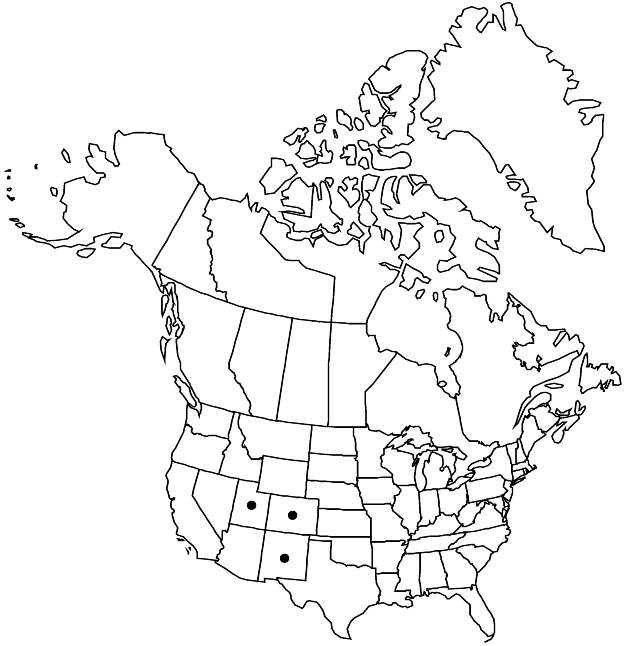Eriogonum lonchophyllum
Proc. Amer. Acad. Arts 8: 173. 1870.
Shrubs, subshrubs, or herbs, spreading to erect, not scapose, (1–)1.5–5 × 2–5(–8) dm, glabrous or rarely floccose to tomentose, grayish. Stems spreading or erect, usually without persistent leaf bases, up to 1/2 or more height of plant; caudex stems absent or matted to spreading; aerial flowering stems spreading to erect, slender, solid, not fistulose, 0.3–3 dm, glabrous or, rarely, floccose to tomentose, tomentose among leaves. Leaves basal or cauline on proximal 1/2 of stem, 1 per node; petiole 0.5–2 cm, tomentose to floccose or glabrous; blade narrowly lanceolate or oblanceolate to elliptic, 1.5–7(–9) × 0.2–2 cm, velvety- to densely white-tomentose abaxially, sparsely tomentose to thinly floccose or glabrous and green adaxially, margins plane or occasionally crenulate. Inflorescences cymose, dense to more commonly open, 2–25 × 2–20 cm; branches dichotomous, glabrous or, rarely, floccose; bracts 3, scalelike, usually triangular, and 1–3 mm, or occasionally leaflike, 8–30 mm, and otherwise similar to leaf blades. Peduncles absent or erect, 0.1–0.8 cm, glabrous. Involucres 1 per node or 2–5 per cluster, turbinate to turbinate-campanulate, 2.5–4 × (1.3–)1.5–3.5(–4) mm, glabrous; teeth 5, erect, 0.4–0.9 mm. Flowers 2–3.5(–4) mm; perianth white, glabrous; tepals connate proximal 1/4–1/3, monomorphic, oblanceolate, elliptic to oblong or obovate; stamens exserted, 2–4 mm; filaments pilose proximally. Achenes light brown to brown, 2–3 mm, glabrous except (typically) for slightly papillate beak.
Phenology: Flowering Jun–Oct.
Habitat: Heavy gumbo clay soil or (at higher elevations) sandy-loam to gravelly or rocky soil and outcrops, mixed grassland, saltbush, blackbrush, and sagebrush communities, pinyon-juniper and montane conifer woodlands
Elevation: 1400-2900 m
Distribution

Colo., N.Mex., Utah.
Discussion
Eriogonum lonchophyllum is widespread and occasionally rather common in sagebrush-dominated communities in the Rocky Mountains of Colorado, northern New Mexico and eastern Utah. The distribution is fragmented, many of the populations are markedly distinct, and several have been provided with names. The continued recognition of E. coloradense is probably dubious given what is already reduced here to synonymy under E. lonchophyllum. Eriogonum lonchophyllum typically has glabrous flowering stems and inflorescence branches, yet floccose to tomentose individuals are known from Eagle (Reveal & Davidse 861, UTC) and Garfield (Goodrich & D. Nelson 24582, BRY) counties in Colorado. Plants representing the typical expression of the species differ from the majority of populations assigned here in having broad leaves and a sprawling habit. Such plants grow in deep shade under tall conifers and are known currently only from the type locality. Variation in the size, shape, and distribution of leaves has been used to distinguish varieties of E. lonchophyllum. At their extremes, the differences are remarkable. For example, plants with linear, basal leaves have been named var. nudicaule. Such plants are found in the New Mexico counties of Rio Arriba, Sandoval, and Santa Fe. Another herbaceous phase also with basal, but broader leaves and known from the Book Cliffs and Tavaputs Plateau regions of northeastern Emery, southern Uintah, and northern Grand counties, Utah, and in Rio Blanco County, Colorado, has been named var. intermontanum. The low, spreading subshrubby phase found along the foothills of the Front Ranges in south-central Colorado (El Paso, Fremont, Jefferson, Las Animas, Otero, and Pueblo counties) and adjacent north-central New Mexico (Colfax and Taos counties) is known as var. fendlerianum. These plants have velvety, tomentose leaf blades. Another shrubby phase is found in and around the Dinosaur National Park in Daggett and Uintah counties, Utah, and in northwestern Rio Blanco County, Colorado. This is var. saurinum, characterized by having sheathing leaf blades along the flowering stems that vary from narrowly oblanceolate to narrowly elliptic; it is occasionally confused with E. corymbosum in that area. At the north end of Mesa Verde National Park and on Sleeping Ute Mountain of Montezuma County, Colorado, is a large shrub that outwardly resembles E. corymbosum in size and shape. It is similar to, but larger than, the more eastern var. fendlerianum. The most common phase of the species (as represented by var. humivagans, including E. salicinum, E. scoparium, and E. tristichum) is found mainly on fine, clayey to gravelly, alluvial soils in the Rocky Mountains and western desert ranges of Colorado (Archuleta, Delta, Dolores, Eagle, Garfield, Gunnison, La Plata, Mesa, Moffat, Montezuma, Montrose, Ouray, Rio Blanco, Saguache, and San Miguel counties), northern New Mexico (Rio Arriba, Sandoval, and San Juan counties), and San Juan County, Utah. The majority of the plants have long, narrow leaf blades (2–5 mm wide), but populations with broader leaves are common in southwestern Colorado. It is this latter expression of E. lonchophyllum that can be difficult to distinguish from E. corymbosum in portions of eastern Utah and western Colorado. A single collection (Rammel s.n., 1872, MIN, US) was supposedly gathered in Texas. Until this is confirmed, the species is not considered to be part of the Texas flora.
Selected References
None.